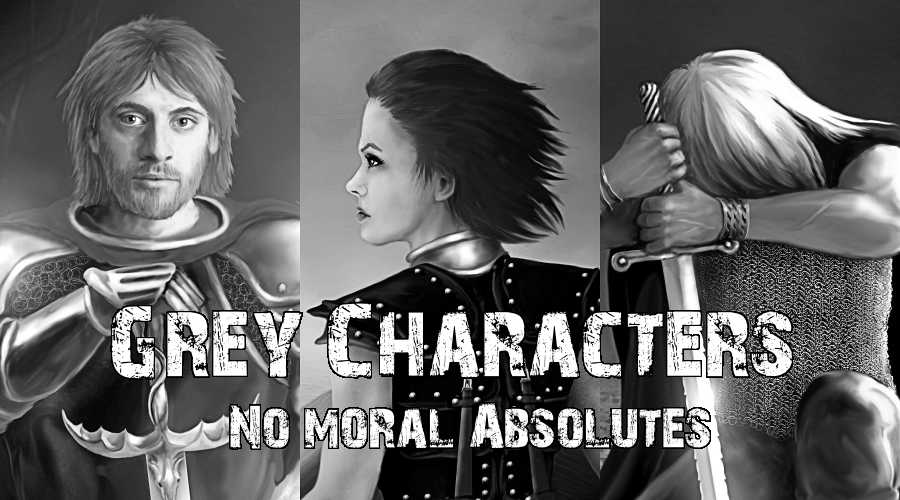
One of the comments I get about my books is that all the characters are grey. That means that you can’t just plunk a black or white hat on them and say definitively whether they are good or evil. Go through the people in your life and try to list which ones are good and which are evil (just not someplace where it will be seen). Grandma … good. Boss … evil. Neighbor down the hall … good. Neighbor upstairs … evil. If you can even take the exercise seriously, you’re oversimplifying. Grandma might bake you cookies, but she cheats on her taxes. Your boss might be your tormentor from 9-5, but he coaches a youth soccer team. Your perception of your neighbors is strongly influenced by how much you can hear the noise from their apartments.
How do you use this?
OK, finding the little grey areas in your personal circle of acquaintances is interesting, but it doesn’t help you write. How can you translate this into making realistic “grey” characters.
Step 1: Eliminate Good and Evil
It’s fine to have your protagonist and antagonist defined; that’s storytelling. But as soon as you classify someone as “good” or “evil” you’ve oversimplified them. Sure, maybe you can come up with a philosophical dividing line where you can assign labels based on sins/per/day or tick off the 7 deadly sins like they are a personality test. The start to believably grey characters is to get yourself away from black-and-white labeling, for starters.
Step 2: Goals and Motivations
Once, you’ve taken away Good and Evil, you need to motivate your characters. “Doing Good” and “Being Evil” were too simple. A knight doing his duty may embody everything you feel Good encompasses, but he’s probably performing those duties because of a sense of obligation, a fear of letting down superiors who have put their faith in him, or out of a desire for the adulation of those he protects. When you peel back the blackened skin of an “evil overlord” stereotype, you may find a grim public servant who it willing to crack a few eggs to make his omelet, a shrewd politician who has gotten everything he’s wanted and it now paranoid about losing power, or a privileged aristocrat who feels righteously offended when his peasants thwart his wishes.
Whatever you choose, try to make the motivation that a reader can relate to. Your antagonists aren’t our to destroy the world because it’s in their villain contract; let them believe that they are ushering in a glorious new era. Don’t have your protagonist feel like he’s been chosen to save the world; have him join a quest to show up his overbearing elder brother.
Step 3: Show the Other Side
The goody-two-shoes is an annoying character. The evil overlord is cliche. However, you can turn either one of them grey by showing the other side of the coin. This isn’t just a quirk or a villain’s pet the dog moment, but an actual redeeming quality. Give the good-two-shoes a vice, too, or at the very least play their holier than thou attitude up as a social flaw.
Ideas for redeeming antagonists (even “villains” can be a bit of a loaded, non-grey term):
- Give them someone they are intent on saving or protecting.
- Have them follow a set of morals that differ from the protagonist’s, but are perfectly valid and lauded among his or her own people.
- Make the traits that spark their darker deeds trouble them. Soul-searching is good evidence of a soul.
- Find a virtue and have them display it. If you need a list of virtues, you can find one almost anywhere.
Ideas for tarnishing the squeaky-clean antagonist:
- Give them a selfish motive for their heroism, even if it’s not their only motive.
- Have them react badly to a particular person or situation, in a way that seems out of character until closely examined (prejudice, bad memory, rumor she or she heard, etc.).
- Give them a nasty habit.
- Pick one of the deadly sins and make them vulnerable to it. Lust and greed are plenty understandable and can be forgiven by the reader. Wrath in the cause of vengeance is another good “dark” trait for a hero. Gluttony and sloth are annoying traits for a protagonist, and envy is petty. Pride is often better suited to an antagonist until your protagonist is going to fail because of it. Unpunished, overblown pride is another trait likely to upset readers (and not in the “oh look, the author did something unique and different” manner).
With these thoughts in mind, consider scuffing up your heroes and villains so they don’t have that “fresh from the trope box” look. Grey is the new black. Grey is the new white.

Thanks for this article. This is really helpful for me. I am working on an antagonist and was having a bit of trouble defining him. Thanks to this article, I know what to do to tweak him.
The best is when you can get people to hate an antagonist, while at the same time completely believing in them as a human.
Further, I want the reader to question their own judgement of good versus “bad”. One said, “I didn’t want any of them to get hurt.” Hooray!
Wow! You nailed it here.
These are great ideas for showing the other side that I will use.
Glad to be of service. I have a hard time watching/reading stories where certain characters seem just slotted into good/evil buckets.